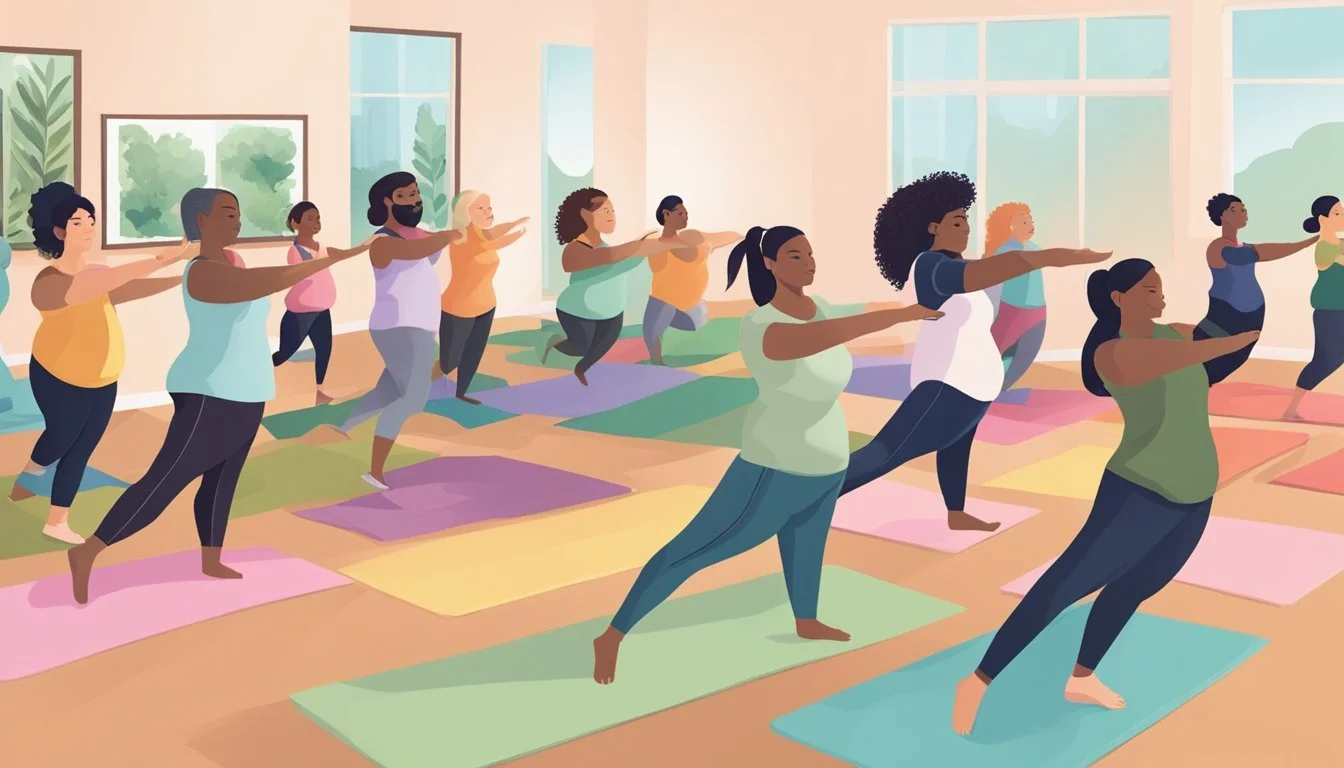9 Unconventional Techniques for Improving Body Image
Unique Approaches to Self-Acceptance
Body image issues affect countless individuals, impacting self-esteem and overall well-being. While traditional approaches to improving body image exist, unconventional techniques can offer fresh perspectives and innovative solutions. These alternative methods challenge conventional wisdom and provide unique ways to foster a healthier relationship with one's physical appearance.
Exploring unconventional techniques for improving body image can lead to transformative experiences and lasting positive changes. This article presents nine unusual strategies that go beyond typical advice, offering readers new tools to cultivate self-acceptance and appreciation for their bodies. By embracing these non-traditional approaches, individuals may discover effective ways to break free from negative thought patterns and develop a more positive body image.
1) Mirror Exposure Therapy
Mirror exposure therapy is an unconventional technique used to improve body image. This approach involves systematically observing one's body in a mirror without judgment or criticism. The goal is to challenge negative perceptions and promote self-acceptance.
During a session, individuals stand in front of a full-length mirror and describe their body parts objectively. They focus on neutral observations rather than emotional reactions or harsh self-critique. This practice helps reduce anxiety associated with body image concerns.
Therapists may guide clients through the process, encouraging them to view their bodies compassionately. Over time, repeated exposure can decrease body-related distress and avoidance behaviors. Participants often report increased comfort with their appearance and reduced negative self-talk.
Research suggests mirror exposure therapy can be effective for various body image issues, including eating disorders and body dysmorphic disorder. It is typically used as part of a comprehensive treatment plan, often in conjunction with cognitive-behavioral therapy.
While initially challenging, many find this technique transformative. It helps individuals develop a more balanced and realistic view of their bodies, fostering greater self-acceptance and confidence.
2) Affirmation Journaling
Affirmation journaling combines the power of positive self-talk with the practice of writing. This technique involves regularly writing down supportive statements about one's body and self-image.
Individuals can create a dedicated journal for body-positive affirmations. Each day, they write several affirming statements such as "My body is strong and capable" or "I appreciate my body's unique features."
The act of writing these affirmations helps reinforce positive beliefs about one's body. Over time, this practice can shift negative thought patterns and improve overall body image.
Affirmation journaling can be particularly effective when done consistently. Many find it helpful to set aside a specific time each day for this practice, such as first thing in the morning or before bed.
To enhance the impact, individuals can personalize their affirmations. They might focus on specific body parts they struggle with or aspects of their appearance they want to appreciate more.
Some people find it beneficial to read their affirmations aloud after writing them. This multi-sensory approach can further reinforce the positive messages and make them more impactful.
3) Body Neutrality Practices
Body neutrality focuses on accepting one's body as it is, without attaching positive or negative labels. This approach can be a helpful alternative for those who struggle with body positivity.
One practice is to acknowledge the body's functions rather than its appearance. For example, appreciating how legs allow movement or hands enable daily tasks.
Another technique involves using neutral language when describing oneself. Instead of critiquing or praising physical features, individuals can simply state facts without judgment.
Mindfulness exercises can support body neutrality. Paying attention to physical sensations without assigning value can help cultivate a more neutral relationship with the body.
Journaling about the body's capabilities and experiences, rather than its looks, can shift focus away from appearance-based assessments.
Engaging in activities for enjoyment rather than changing one's body shape can promote a more neutral mindset. This might include dancing, swimming, or hiking for pleasure.
Surrounding oneself with diverse body representations in media and social circles can help normalize body diversity and reduce comparison tendencies.
4) Media Literacy Workshops
Media literacy workshops empower individuals to critically analyze and interpret media messages about body image. These workshops teach participants to deconstruct unrealistic beauty standards portrayed in advertisements, social media, and entertainment.
Participants learn to identify digital manipulation techniques used to alter images. They gain skills to recognize subtle marketing tactics that promote idealized body types. This knowledge helps reduce the internalization of unrealistic beauty standards.
Workshops often include interactive activities where participants create their own media content. This hands-on approach allows them to understand the construction of media messages from the inside out.
Group discussions encourage sharing personal experiences with media influence on body image. These conversations foster a supportive environment and help participants realize they are not alone in their struggles.
Media literacy workshops equip individuals with tools to navigate the digital landscape more confidently. By understanding media's role in shaping body image perceptions, participants can develop a more balanced and realistic view of themselves and others.
5) Positive Self-Talk Exercises
Positive self-talk exercises can be powerful tools for improving body image. These techniques involve consciously replacing negative thoughts with more affirming ones.
One effective method is the mirror exercise. Individuals stand in front of a mirror and voice positive statements about their appearance and capabilities. This practice helps rewire negative thought patterns over time.
Another technique is the gratitude list. People write down aspects of their body they appreciate, focusing on function rather than appearance. This shift in perspective can foster a more positive relationship with one's physical self.
Affirmation cards provide another avenue for positive self-talk. These cards contain uplifting statements that can be read aloud daily. Regular repetition of these affirmations can help reinforce a more positive self-image.
Journaling about body-related thoughts and reframing them in a more positive light is also beneficial. This practice allows for reflection and conscious redirection of negative self-talk.
Incorporating these exercises into daily routines can gradually transform how individuals perceive and speak to themselves about their bodies.
6) Mindful Movement Classes
Mindful movement classes offer a unique approach to improving body image. These classes combine physical exercise with mindfulness techniques, creating a holistic experience for participants.
During these sessions, individuals engage in gentle movements while maintaining awareness of their body sensations. This practice helps foster a deeper connection between mind and body.
Participants learn to appreciate their bodies for their capabilities rather than focusing solely on appearance. The classes often incorporate yoga, tai chi, or other low-impact exercises that emphasize body awareness.
Instructors guide attendees through various postures and movements, encouraging them to notice how their bodies feel without judgment. This non-critical approach helps cultivate self-compassion and acceptance.
Regular attendance in mindful movement classes can lead to increased body satisfaction and reduced negative self-talk. Participants often report feeling more at ease in their own skin and developing a more positive relationship with their bodies.
These classes provide a supportive environment where individuals can explore their physical limits without pressure or competition. The focus is on personal growth and self-discovery rather than achieving specific fitness goals.
7) Gratitude for Your Body Sessions
Practicing gratitude for one's body can significantly improve body image. This technique involves regularly acknowledging and appreciating the various functions and capabilities of the body.
To implement this technique, individuals can set aside time each day for a body gratitude session. During these sessions, they focus on different parts of their body and express thanks for their abilities.
For example, one might appreciate their legs for allowing them to walk, run, or dance. They might express gratitude for their hands, which enable them to create, touch, and interact with the world.
Writing down these thoughts of gratitude can enhance the impact. Using a journal or notepad, individuals can list specific aspects of their body they're thankful for each day.
This practice helps shift focus from appearance to functionality, fostering a more positive relationship with one's body. Over time, it can lead to increased body acceptance and improved self-esteem.
8) Self-Compassion Meditations
Self-compassion meditations offer a powerful technique for improving body image. These practices encourage individuals to treat themselves with kindness and understanding, especially when facing body-related concerns.
Research indicates that self-compassion meditation can significantly decrease body dissatisfaction. Participants in one study maintained positive feelings about their bodies even three months after practicing these meditations.
The practice typically involves settling into a comfortable position and shifting focus inward. Practitioners are guided to send words of loving-kindness to their bodies, fostering acceptance and awareness.
A body scan meditation is a common form of self-compassion practice. It involves systematically focusing attention on different parts of the body, acknowledging sensations without judgment.
These meditations help reframe negative body thoughts and cultivate a more positive self-image. By regularly practicing self-compassion, individuals can develop a healthier relationship with their bodies.
Self-compassion meditations can be done independently or with guided audio. Many resources are available online, including videos and apps, making this technique accessible to a wide range of people.
9) Non-Comparative Social Media Use
Social media can significantly impact body image, especially when users frequently compare themselves to others. Reducing overall social media use has been shown to improve body image in teens and young adults.
However, complete abstinence from social media may not be realistic or desirable for many. Instead, focusing on non-comparative social media use can be beneficial.
This approach involves mindfully engaging with social media without making appearance-based comparisons. Users can curate their feeds to include diverse body types and focus on content that doesn't emphasize physical appearance.
Following accounts that promote body positivity and self-acceptance can help shift perspective. Engaging with content related to hobbies, interests, and personal growth can also redirect focus away from appearance-based comparisons.
Setting time limits for social media use and being intentional about the content consumed can further support non-comparative engagement. This technique allows individuals to stay connected while minimizing negative impacts on body image.
Understanding Body Image
Body image encompasses our perceptions, thoughts, and feelings about our physical appearance. It plays a crucial role in self-esteem and overall well-being, influenced by personal experiences and societal factors.
Defining Body Image
Body image refers to how individuals perceive, think, and feel about their bodies. It includes mental representations of physical appearance and bodily experiences. This concept extends beyond mere visual aspects, incorporating sensations, functions, and capabilities.
Body image can be positive, negative, or fluctuating. A positive body image involves acceptance and appreciation of one's body, while a negative body image may lead to dissatisfaction and distress.
Key components of body image include:
Perceptual (how one sees their body)
Cognitive (thoughts and beliefs about appearance)
Emotional (feelings related to body and appearance)
Behavioral (actions influenced by body image)
Psychological Impact of Body Image
Body image significantly affects mental health and self-esteem. A negative body image can contribute to:
Low self-confidence
Depression and anxiety
Eating disorders
Social withdrawal
Conversely, a positive body image promotes:
Better stress management
Improved relationships
Greater overall life satisfaction
Body image concerns often emerge during adolescence but can persist throughout adulthood. They may be influenced by personal experiences, comparisons with others, and media exposure.
Social and Cultural Influences
Society and culture play significant roles in shaping body image. Factors include:
Media portrayals of idealized bodies
Cultural beauty standards
Peer and family attitudes towards appearance
Social media and comparison culture
These influences can create unrealistic expectations and pressure to conform to specific body types. Different cultures may emphasize various physical attributes as desirable, impacting individual body image perceptions.
Gender also plays a role, with women often facing more intense scrutiny regarding appearance. However, men increasingly experience body image concerns as well.
Recognizing these influences is crucial for developing a healthier body image and promoting body diversity acceptance.
Mindfulness and Self-Compassion
Mindfulness and self-compassion provide powerful tools for transforming one's relationship with their body. These practices foster awareness, acceptance, and kindness towards oneself.
Practicing Mindfulness
Mindfulness involves paying attention to the present moment without judgment. To cultivate body image mindfulness, set aside time daily to scan your body, noticing sensations without criticism. Focus on how your body feels and functions rather than its appearance.
Try mindful eating by savoring each bite and listening to hunger cues. This can reduce emotional eating and improve your relationship with food. Incorporate mindful movement like yoga or tai chi to appreciate your body's capabilities.
When negative thoughts arise about your appearance, observe them without attachment. Label the thoughts as "thinking" and let them pass. This creates distance from harmful self-criticism.
Embracing Self-Compassion
Self-compassion means treating yourself with the same kindness you'd offer a friend. When struggling with body image, speak to yourself gently. Replace harsh self-talk with understanding phrases like "It's natural to feel insecure sometimes."
Practice loving-kindness meditation by directing well-wishes towards yourself. Say "May I be healthy. May I feel comfortable in my body." Extend compassion to others facing similar struggles.
Write a compassionate letter to your body, thanking it for all it does. Acknowledge its strengths and unique features. Focus on gratitude for your body's abilities rather than its looks.
When you catch yourself being self-critical, pause and ask "What would I say to a friend in this situation?" Then offer yourself that same support and understanding.





